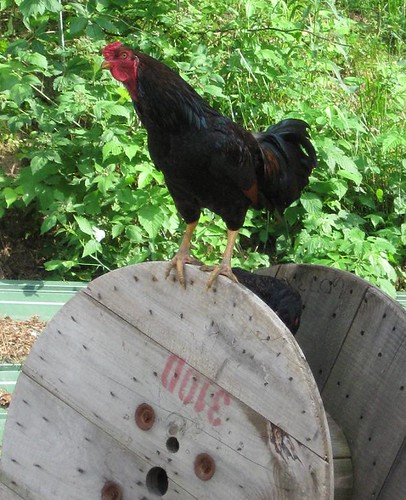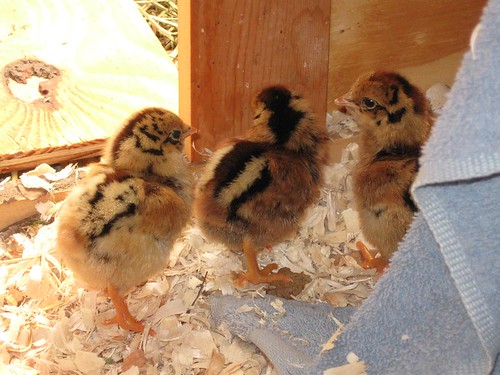
Last year we kept a rooster with our flock for the first time. I've heard my share of rooster horror stories but after we discovered the Dark Cornish I fell in love. So much in love I wanted a breeding flock, which meant keeping a rooster. I admit I chose our first rooster in part because of his color. He had "blazing saddles"... fantastic orange near his tail that contrasted so beautifully against his dark browns and emerald greens. I fell hard for the little guy. He
was little when we chose him. Our first Dark Cornish batch was raised later than our batches of Cornish Rocks and Wyandottes. By the time we got to sorting through the Dark Cornish batch for keepers, the Wyandotte laying flock had been chosen.
Our darling little rooster was named Rusty for his flashes of orange and brought down off the hill (where we pasture our meat birds) and confined for a time with two Dark Cornish hens from the same batch. We had the three penned with some three foot chicken wire so they could get acquainted with the Wyandottes visually before joining them. Being younger, they were markedly smaller than the Wyandottes that patrolled the area peering at them. After some time we placed the Dark Cornish with the Wyandottes. The Dark Cornish hens adjusted, though they were low in the pecking order, but poor Rusty had a difficult time. He wasn't a hen, but the Wyandottes still insisted on harrassing him, endlessly, because he was small. It was the most difficult adolesence a bird could have, if you asked him. Eventually he got a little of the size his breed is known for, but he remained quite friendly to us - the people - and generally passive with the Wyandotte hens. With the hens of his own breed he achieved some status and went about the normal mission of a rooster, to serve and protect. But then there were only two hens of his kind to worry over.
Finally spring rolled around. Spring holds a lot of meaning for a rooster. Namely, it means mating. Or should I say, MATING. It is that important. To a rooster. Suddenly Rusty rose from his meek beginnings and began hassling the Wyandottes, even, dare I say, choosing a few of them to be part of
his flock. I was very proud of my little rooster, who wasn't little any more. But then it happened. I'd put the horror stories out of my mind for so long, had fed my pet rooster and cared for him through a long, cold winter, and then, BAM! I went to check the flock after a brief trip to town, stepped out of the henhouse after gathering eggs and... what?! Something kicked/hit/grabbed my leg and pounded on my foot! It all happened so suddenly that by the time I looked down at my pummeled foot I just saw feathers ceasing to flap and my sweet Rusty peering up at me a step away.
I convinced myself that Rusty was having a reaction to my shoes. I'd just gotten back from town and was wearing sneakers for the first time in months. He was only familiar with my winter boots, so I was certain something about the sneakers set him off. I was very surprised when I took said sneaker out and set it down near him and backed up. No reaction. Not even a glance. This was concerning. If it wasn't the sneaker, then what? Surely my pet didn't suddenly decide he didn't like me. But sadly I was wrong. Time passed and Rusty perfected his attacks. He saw me and ran around the greenhouse (set up for the hens' winter leasure when it was cold). It appeared he was running away, but I moved slowly, suspecting he'd gone from random attacks to plotting. As I approached the door of the greenhouse Rusty burst around the corner, rushing my feet. Another time I was walking back to check eggs and I saw Rusty in the distance. There was a flatbed trailer parked along the poleshed that I needed to walk by. When I noticed Rusty suddenly disappear on the far end of the trailer from me I looked down to see him running from under the trailer closest to me, again at my feet.
My darling boy became known as the ankle kicker. He was an amazing watch rooster. I knew when anything was amiss or if someone walked or drove on the property. He kept a constant lookout, out in the open while the hens stayed under brush cover, and would crow when his idea of trouble came anywhere near. Unfortunately I was now his idea of trouble and I spent the next three or more months carrying a light pitchfork or other deterrent to fend off any mid-flight attacks. I didn't club him or brutalize him in any way, the outcome of so many of those rooster horror stories. I just attempted to protect my ankles (and feet and hands and anything else that might be exposed). We agreed to disagree until some of our marvelous hens hatched some chicks fathered by Rusty. In the end Rusty went the way of the chicken in noodle soup. He was a good rooster, but such a disagreement could only go on so long.
Since then we've chosen our new rooster, named Chief. He's a hulk of a guy, largest chest I've seen and heavy as a rock. He's not as flashy as Rusty but he's got the personality of a leader. As usual, when we were sorting birds on the hill in the fall, many got out of their "chicken tractor" pens. Chief was one of them. When he freed himself he contentedly went to work picking through a cow patty and clucked insistently at a group of hens that were also out. He was showing the hens that he'd found food for them, and like a good rooster, he allowed them to eat first before taking any for himself. He kept a close eye on the sky, too, and made the appropriate vocal warnings when anything flew overhead. His demeanor with the hens was gentle and he was large. Outside of being average-looking, he was everything we could have wanted, so the choice was made.
Having finally set my protective pitchfork down and been able to walk about the farm doing chores without looking over my shoulder, I was concerned about my future with another rooster. I read up on how to keep them and how to keep peace with them. My husband reassured me this guy was sweet. He'd pick him up and the giant would go limp, no fighting. He'd scratch his chest and the rooster would merely peer back and blink. Things were good and I finally got around to a little chest scratching and conversation with him, too. I was convinced that things would be different. This guy had been exposed to more (namely a pushy little puppy that insisted on sticking his nose deep into chickens' feathery butts to say "hi"). I thought he was worldlier and that we had an understanding that I was the farmer, just there to assist in taking care of his "girls". Oh, we were great friends. It was fantastic.... Then we had a warm day. And then another warm day. Apparently we didn't have an understanding. I just had the advantage of some serious cold that hampered Chief's ability to really flex his birdy might. A little rise in temperature and this guy was warmed up. So one blood blister later (they grab with their beaks - did you know that?) and some strong and assertive pecks on my rubber boot and I'm thinking.... better get my pitchfork out.





